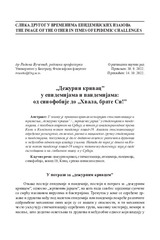Приказ основних података о документу
’Dežurni krivac’ u epidemijama i pandemijama: od sinofobije do ‘Hvala, brate Si’!
| dc.creator | Vučetić, Radina | |
| dc.date.accessioned | 2023-12-06T20:07:05Z | |
| dc.date.available | 2023-12-06T20:07:05Z | |
| dc.date.issued | 2022 | |
| dc.identifier.issn | 0354-5318 | |
| dc.identifier.uri | http://reff.f.bg.ac.rs/handle/123456789/5602 | |
| dc.description.abstract | Ever since there have been pandemics, there has been a search for the “scapegoat,” on whom all the anger of the community faced with the fear of death falls. Throughout history, the “scapegoat” has been sought for plague, cholera, smallpox, Spanish flu, HIV, Ebola, and various epidemics and pandemics, including the coronavirus (covid-19) pandemic, leading to discrimination and violence, most often directed towards a specific ethnic or religious group. Immediately after the announcement of the coronavirus pandemic, the Chinese became targets of attacks. The attacks on the Chinese also had a political dimension, mainly due to the rise of China’s political and economic power at the beginning of the 21st century. When it comes to Serbia, while the virus has not yet reached Serbia, the discourse about China as the “scapegoat” mainly was taken from foreign media. However, the situation quickly changed because this dominant discourse did not coincide with Serbian foreign policy and the “strategic partnership” between Serbia and China. Already in the first month since the declaration of the pandemic in Serbia, China has become the leading partner in the fight against the pandemic. The billboards represented the peak of the outpouring of friendship, spelling “in gratitude to Chinese leader Xi Jinping”. Even though China and the Chinese were considered “scapegoats” in many parts of the world, Serbia followed a different behavioral model during the pandemic. This included strengthening its friendship with China and growing populism and authoritarianism. | sr |
| dc.language.iso | sr | sr |
| dc.publisher | Udruženje za društvenu istoriju, Filozofski fakultet Univerziteta u Beogradu | sr |
| dc.relation | Projkat ,,Čovek i društvo u vreme krize” finansiran od strane Filozofskog fakulteta Univerziteta u Beogradu | sr |
| dc.rights | openAccess | sr |
| dc.rights.uri | https://creativecommons.org/licenses/by/4.0/ | |
| dc.source | Godišnjak za društvenu istoriju | sr |
| dc.subject | dezurni krivac | sr |
| dc.subject | stigmatizacija | sr |
| dc.subject | epidemija | sr |
| dc.subject | pandemija | sr |
| dc.subject | sinofobija | sr |
| dc.subject | COVID-19 | sr |
| dc.subject | Kina | sr |
| dc.subject | srpsko-kineski odnosi | sr |
| dc.title | ’Dežurni krivac’ u epidemijama i pandemijama: od sinofobije do ‘Hvala, brate Si’! | sr |
| dc.type | article | sr |
| dc.rights.license | BY | sr |
| dc.citation.epage | 137 | |
| dc.citation.issue | 3 | |
| dc.citation.rank | M24 | |
| dc.citation.spage | 121 | |
| dc.identifier.fulltext | http://reff.f.bg.ac.rs/bitstream/id/13467/bitstream_13467.pdf | |
| dc.identifier.rcub | https://hdl.handle.net/21.15107/rcub_reff_5602 | |
| dc.type.version | publishedVersion | sr |

